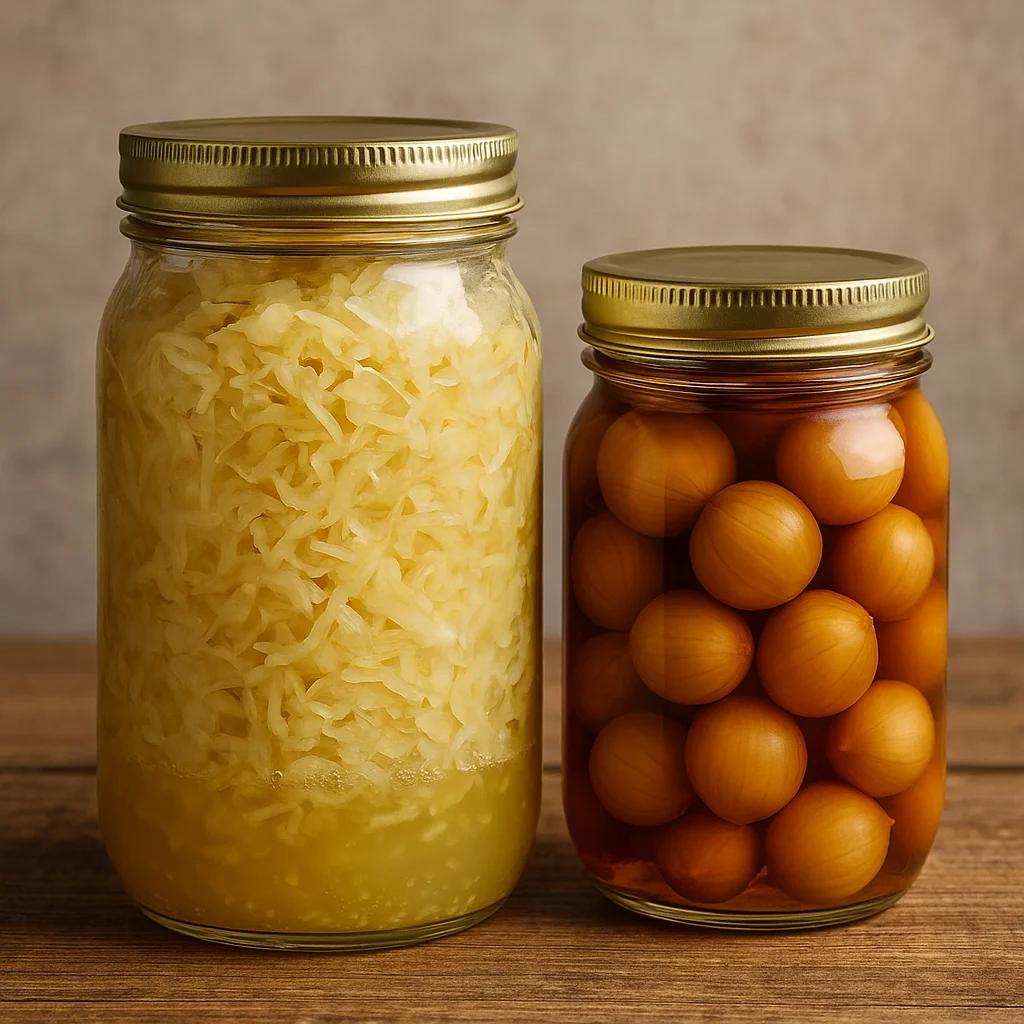
Pickling vs Fermentation: What’s the Real Difference?
People often use the words interchangeably—but they’re not the same. This guide walks through the plain-English differences so you know which method to choose for flavour, texture, storage and gut-friendly ferments.
Quick Answer
Fermentation is when microbes (like lactic acid bacteria) convert the natural sugars in food into acids over time, so the food self-acidifies. Pickling is when you put food straight into an acidic liquid—usually vinegar—so it’s sour from day one. Fermented veg rely on salt, time and microbes; pickles rely on a correctly made vinegar brine.
Free Fermentation Safety Checklist
If you’re fermenting vegetables, not just vinegar pickling, get my Fermentation Safety Checklist (PDF) and avoid common beginner mistakes with salt, brine and surface issues.
Get the Free ChecklistDefinitions (short and sharp)
Fermentation is when microbes convert natural sugars into acids, gases and other compounds so the food changes gradually over days or weeks. With veg ferments, lactic acid bacteria produce lactic acid, which sours and preserves the food.
Pickling is when you place food in a pre-made acidic liquid—normally vinegar with water, salt and sometimes sugar and spices—so the acidity is there from the start.
Method at a glance
This table shows the main differences side by side:
| Aspect | Fermentation | Pickling |
|---|---|---|
| Acidity source | Produced by microbes (lactic acid bacteria) | Added directly (vinegar / acidic brine) |
| Time | Days to weeks, depending on temperature and taste | Immediate sourness; flavour develops over hours to days |
| Flavour | Complex, tangy, evolving; often deeper and more savoury | Bright, sharp, consistent; vinegar-forward |
| Equipment | Jar or crock, salt, way to keep veg under brine and limit oxygen | Jar, vinegar-based brine that fully covers the food |
| Examples | Sauerkraut, kimchi, fermented hot sauce, curtido | Pickled onions, gherkins, beetroot, quick pickled veg |
Safety basics (headline principles only)
Both methods can be safe at home if you follow tested recipes and a few simple rules.
- Fermentation: use a suitable salt level, keep vegetables pushed below the brine, and keep the surface protected from oxygen. Discard ferments with fuzzy mould, strange colours or rotten smells.
- Pickling: use food-grade vinegar of known strength, follow a tested brine recipe, and make sure the liquid fully covers the food in clean jars.
This article doesn’t give exact formulas—those live in full recipes and books—but understanding the principles helps you choose the right method and then follow instructions with confidence.
Flavour and texture differences
Fermented veg and vinegar pickles can both be sour, but they don’t taste the same.
- Fermented veg: tangy, layered acidity with savoury depth. Flavour builds over time and can include subtle butter, cheese or fruit notes depending on the ferment.
- Vinegar pickles: bright, sharp, often a little sweeter. The vinegar’s character (malt, cider, wine) comes through clearly.
Texture can differ too. Well-made ferments stay pleasantly crisp when salt and temperature are right. Vinegar pickles can be firm or softer depending on the recipe and how they’re processed.
Which should you use?
- Want fast results? Vinegar pickling gives you sour veg within hours to a couple of days.
- Want probiotics and depth? Fermentation creates live-culture foods with more complex flavour—great for kraut, kimchi and fermented sauces.
- Want bright, sharp salads and toppings? Pickled onions, carrots and cucumbers shine in this role.
- Want complex sauces and condiments? Fermented hot sauce and kraut juices deliver layered flavour that vinegar sauces can’t fully mimic.
- Thinking about gut health? Fermented foods that contain live cultures (beneficial bacteria and yeasts) can help add microbial variety to your diet. Choose unpasteurised, refrigerated products—or make your own at home. Heat-treated versions won’t contain live microbes.
Want clear, tested methods for both?
My beginner-friendly books walk you through exact salt levels, vinegar strengths, safe storage and troubleshooting using UK measurements and supermarket ingredients.
Start the right way
For step-by-step methods, UK-specific guidance and practical troubleshooting, these titles are a solid starting point:
Fermentation for the Absolute Beginner Pickling for the Absolute Beginner
Summary
Fermenting uses salt, time and microbes to let food slowly create its own acid and complex flavour. Pickling uses a ready-made acidic brine to give instant sharpness and reliable sourness. Both can be safe and delicious if you follow tested recipes and respect the basics: correct salt and submersion for ferments; correct vinegar strength and full coverage for pickles. Once you understand the difference, it’s much easier to choose the right method for each ingredient—and to get repeatable, safe results at home.